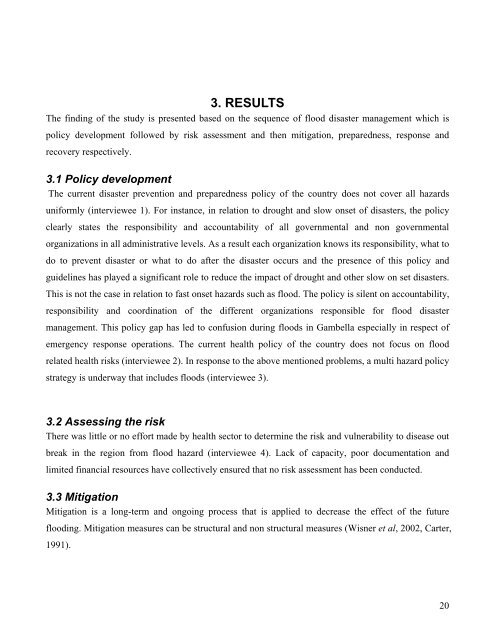Floods and Health in Gambella region, Ethiopia: An ... - lumes
Floods and Health in Gambella region, Ethiopia: An ... - lumes
Floods and Health in Gambella region, Ethiopia: An ... - lumes
You also want an ePaper? Increase the reach of your titles
YUMPU automatically turns print PDFs into web optimized ePapers that Google loves.
3. RESULTS<br />
The f<strong>in</strong>d<strong>in</strong>g of the study is presented based on the sequence of flood disaster management which is<br />
policy development followed by risk assessment <strong>and</strong> then mitigation, preparedness, response <strong>and</strong><br />
recovery respectively.<br />
3.1 Policy development<br />
The current disaster prevention <strong>and</strong> preparedness policy of the country does not cover all hazards<br />
uniformly (<strong>in</strong>terviewee 1). For <strong>in</strong>stance, <strong>in</strong> relation to drought <strong>and</strong> slow onset of disasters, the policy<br />
clearly states the responsibility <strong>and</strong> accountability of all governmental <strong>and</strong> non governmental<br />
organizations <strong>in</strong> all adm<strong>in</strong>istrative levels. As a result each organization knows its responsibility, what to<br />
do to prevent disaster or what to do after the disaster occurs <strong>and</strong> the presence of this policy <strong>and</strong><br />
guidel<strong>in</strong>es has played a significant role to reduce the impact of drought <strong>and</strong> other slow on set disasters.<br />
This is not the case <strong>in</strong> relation to fast onset hazards such as flood. The policy is silent on accountability,<br />
responsibility <strong>and</strong> coord<strong>in</strong>ation of the different organizations responsible for flood disaster<br />
management. This policy gap has led to confusion dur<strong>in</strong>g floods <strong>in</strong> <strong>Gambella</strong> especially <strong>in</strong> respect of<br />
emergency response operations. The current health policy of the country does not focus on flood<br />
related health risks (<strong>in</strong>terviewee 2). In response to the above mentioned problems, a multi hazard policy<br />
strategy is underway that <strong>in</strong>cludes floods (<strong>in</strong>terviewee 3).<br />
3.2 Assess<strong>in</strong>g the risk<br />
There was little or no effort made by health sector to determ<strong>in</strong>e the risk <strong>and</strong> vulnerability to disease out<br />
break <strong>in</strong> the <strong>region</strong> from flood hazard (<strong>in</strong>terviewee 4). Lack of capacity, poor documentation <strong>and</strong><br />
limited f<strong>in</strong>ancial resources have collectively ensured that no risk assessment has been conducted.<br />
3.3 Mitigation<br />
Mitigation is a long-term <strong>and</strong> ongo<strong>in</strong>g process that is applied to decrease the effect of the future<br />
flood<strong>in</strong>g. Mitigation measures can be structural <strong>and</strong> non structural measures (Wisner et al, 2002, Carter,<br />
1991).<br />
20
















